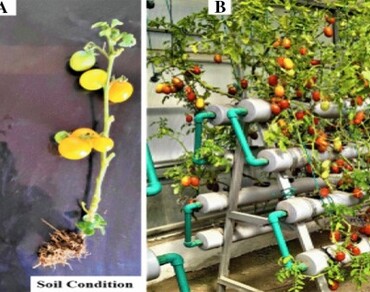Comparative evaluation of physico-chemical response of tomato varieties under hydroponic technique vs soil cultivation in natural ventilated greenhouse at trans-Himalayan India
Research Articles | Published: 29 August, 2022
First Page: 825
Last Page: 832
Views: 3094
Keywords: High altitude, Mineral nutrient, NFT hydroponics system, Tomato, TSS
Abstract
The present study investigated the growth response, yield and nutritional quality of tomato varieties viz. Roma, Tolstoi and Russian yellow grown in circulated nutrient film technique (NFT) hydroponic systems and soil condition at high altitude condition. Both the experiments were carried out in double layer polycarbonate greenhouse condition with open window to maintain favorable atmosphere. Tomato varieties under NFT system exhibited significant improvement in plant height (cm), number of leaf and fruit/plant, fruit fresh weight (g), fruit diameter (mm) and yield compared to soil condition. It was found that 70–80% water was saved in NFT systems compared to soil condition during tomato production. Mineral nutrient contents like Cu, Mn, Mg, Zn and Fe in fresh fruit of tomato grown in hydroponic systems were found higher than soil condition. Total soluble solid (Brix) was found similar in hydroponics and soil condition. Anthocyanin and chlorophyll in tomato leaf were found high in NFT compared to soil condition. From the various aspect of comparative study it was found that NFT system of hydroponics performed better than field grown tomato with respect to shorter harvesting period, higher productivity and quality production of tomato varieties. Since NFT system requires less space and water, this system may be promoted in extreme climatic condition and urban area as an alternative to conventional farming. This research surely opens the avenue of hydroponics technique to increase the income of farmers to promote sustainable development.

References
Agarwal S, Rao AV (2000) Tomato lycopene and its role in human health and chronic diseases. Can Med Assoc J 163(6):739–744
Cardoso FB, Martinez HE, Silva DJ, Milagres CD, Barbosa JG (2018) Yield and quality of tomato grown in a hydroponic system, with different planting densities and number of bunches per plant. PesquiAgropecu Trop 48(4):340–349
Cheng HM, Koutsidis G, Lodge JK, Ashor AW, Siervo M, Lara J (2017) Tomato and lycopene supplementation and cardiovascular risk factors: a systematic review and meta-analysis. Atherosclerosis 257:100–108
Cheng HM, Koutsidis G, Lodge JK, Ashor AW, Siervo M, Lara J (2019) Lycopene and tomato and risk of cardiovascular diseases: a systematic review and meta-analysis of epidemiological evidence. Crit Rev Food Sci Nutr 59(1):141–158
Crozier A, Jaganath IB, Clifford MN (2009) Dietary phenolics: chemistry bioavailability and effects on health. Nat Prod Rep 26(8):1001–1043
Demotes MS, Boumaza R, Meyer S, Cerovic ZG (2008) Indicators of nitrogen status for ornamental woody plants based on optical measurements of leaf epidermal polyphenol and chlorophyll contents. Sci Hortic 115(4):377–385
dos Santos OS, Menegaes JF, Filipetto JE, da Costa LR (2013) Production of tomatoes in hydroponics with different spacings. Pubvet 7:420–548
Hisamitsu TO, Ryuichi O, Hidenobu Y (2001) Effect of zinc concentration in the solution culture on the growth and content of chlorophyll zinc and nitrogen in corn plants (Zea mays L). J Trop Agric 36(1):58–66
Jeuffroy MH, Ney B, Ourry A (2002) Integrated physiological and agronomic modelling of N capture and use within the plant. J Exp Bot 53(370):809–823
Kaaya AN, Namutebi A, Tujjunge J (2002) Chemical and nutrient composition of tomato varieties grown in Uganda. Uganda J Agric Sci 2(2):19–22
Kaur D, Wani AA, Oberoi DP, Sogi DS (2008) Effect of extraction conditions on lycopene extractions from tomato processing waste skin using response surface methodology. Food Chem 108(2):711–718
Kratky BA, Maehira GT, Cupples RJ, Bernabe CC (2005) Non-circulating hydroponic methods for growing tomatoes. Proc Natl Agric Plast Congress 32:31–36
Kratky BA (2003) A suspended pot non-circulating hydroponic method. In: South Pacific Soilless Culture Conference-SPSCC 648, pp 83–89
Mao LZ, Lu HF, Wang Q, Cai MM (2007) Comparative photosynthesis characteristics of Calycanthus chinensis and Chimonanthus praecox. Photosynthetica 45(4):601–605
Melfi MT, Nardiello D, Cicco N, Candido V, Centonze D (2018) Simultaneous determination of water-and fat-soluble vitamins lycopene and beta-carotene in tomato samples and pharmaceutical formulations: double injection single run by reverse-phase liquid chromatography with UV detection. J Food Compos Anal 70:9–17
Mohammed AE, Smit I, Pawelzik E, Keutgen AJ, Horneburg B (2020) Organically grown outdoor tomato: fruit mineral nutrients and plant infection by Phytophthora infestans. Org Agric 10(2):125–134
Parmar DK, Thakur DR, Jamwal RS, Gurudev S (2018) Evaluation of tomato cultivars for yield profit and quality performance in an organic management system in North Western Himalayas India. Int J Curr Microbiol Appl Sci 7(10):498–506
Perveen R, Suleria HA, Anjum FM, Butt MS, Pasha I, Ahmad S (2015) Tomato (Solanumlycopersicum) carotenoids and lycopenes chemistry; metabolism absorption nutrition and allied health claims—A comprehensive review. Crit Rev Food Sci Nutr 55(7):919–929
Sainju UM, Dris R, Singh B (2003) Mineral nutrition of tomato. Food Agric Environ 1(2):176–183
Seleguini A, Seno S, Júnior MJ (2006) Plant spacing and number of inflorescences for tomato crop grown under protected environment. Acta Sci Agron 28(3):359–363
Sharma N, Acharya S, Kumar K, Singh N, Chaurasia OP (2018) Hydroponics as an advanced technique for vegetable production: an overview. J Soil Water Conserv 17(4):364–371
Tariq M, Khan F, Shah AH, Fahad S, Wahid F, Ali J, Adnan M, Ahmad M, Irfan M, Zafar-ul-Hye M, Battaglia ML (2020) Effect of micronutrients foliar supplementation on the production and eminence of plum (Prunusdomestica L). Qual Assur Saf Crop Foods 12(SP1):32–40
Trejo-Téllez LI, Gómez-Merino FC (2012) Nutrient solutions for hydroponic systems. Hydroponics 23:1–22
Author Information
Defence Institute of High Altitude Research (DIHAR)-DRDO, Ladakh, India